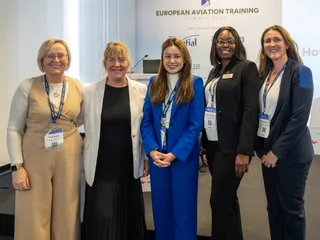How Training Culture Transforms Aviation Safety
Contact Our Team
For more information about how Halldale can add value to your marketing and promotional campaigns or to discuss event exhibitor and sponsorship opportunities, contact our team to find out more
The Americas -
holly.foster@halldale.com
Rest of World -
jeremy@halldale.com

Key Takeaways
- Training culture is the foundational enabler of safety culture, not an optional add-on
- Regulatory compliance represents the minimum standard - airlines must strive for excellence beyond basic requirements
- Continuous learning and coaching must replace traditional "tick-the-box" training approaches
- Cultural sensitivity in training delivery is crucial for international aviation operations
- Instructors must evolve from knowledge deliverers to respected facilitators and life coaches
At the Asia Pacific Aviation Training Summit (APATS) 2025 in Singapore, Trevor Jensen, Cabin Crew Conference Moderator, delivered a thought-provoking presentation on the critical role of training culture in aviation safety. His address challenged conventional thinking about the place of training in the organizational hierarchy and argued for a fundamental shift in how the industry views training investment.
Interested in more key topics for pilot training? Join us at EATS this November to explore the latest developments.
The Foundation of All Aviation Culture
Jensen opened with a powerful assertion that training culture isn't merely a component of corporate culture -it's the foundation upon which all other cultures are built. "It really is foundational. It's not optional," he emphasized, drawing parallels to Australian Aboriginal culture spanning 60,000 years, which developed sophisticated systems of leadership, decision-making, and innovation.
He highlighted an often-overlooked historical fact: "When people say they designed aeroplane wings, no, they didn't. The Australian Aboriginals did somewhere around 60,000 years ago" with the boomerang's aerodynamic principles.
The Cultural Hierarchy in Aviation
Jensen outlined the complex interplay between different cultural layers in aviation organizations. Behind corporate culture lie both national culture and aviation culture, with the latter driven by shareholder focus, regulatory requirements, service standards, and safety protocols.
"Airlines don't exist for safety. They exist to make money for the shareholder, and I think we shouldn't step away from that. It's a simple fact of life," Jensen stated frankly, arguing that acknowledging this reality is essential for honest discussions about safety investment.
The presentation illustrated how corporate culture depends on leadership commitment, which in turn feeds into safety culture, which relies on training culture as its competency enabler. "The competency and safety enabler is, in fact, the training culture that we have," Jensen explained.
Elements of Effective Training Culture
Jensen identified several critical elements that distinguish effective training culture from mere compliance-driven programs:
Relevance and Contemporary Content: Training must be directly applicable to actual job requirements. "It's no use teaching people are going to fly an A320, all about an ATR 42," he noted.
Lifetime Learning: The industry must move beyond initial certification to continuous development. Jensen observed that younger generations entering aviation often lack the foundational interest that previous generations had: "When I was a kid, we used to make model aeroplanes, read about Biggles... Young kids today are entering aviation with no background.. Some of them don't even know what an aeroplane is when they turn up."
Understanding the 'Why': Modern trainees, particularly younger generations, require context and reasoning. "They've got to understand why. They're not going to accept me just standing up the front and saying, "Open the door". Their response: "Why do we have to open the door?"
Innovation in Training Delivery
The presentation highlighted emerging training technologies, particularly podcasts, as simple yet effective learning tools. Jensen expressed enthusiasm about this concept from Singapore Airlines: "If I take away one thing from this conference, it's podcast, the little podcast... How good and how simple is it to make a simple little podcast now? We don't have to have an MGM production."
This approach leverages the 80/20 rule, focusing on message delivery over production perfection, with virtually no cost to airlines beyond staff time.
Cultural Sensitivity in Training
Jensen shared personal experiences illustrating the importance of cultural awareness in training delivery and evaluation. He recounted an incident in Manila where a simple gesture - beckoning with his finger - caused a major complaint because it's considered offensive in Asian culture.
"We have to understand it. And in evaluating people, we can be very free and frank in our western culture... but in an Asian culture, we've got to be more careful," he explained, highlighting the need for culturally appropriate training methods.
Beyond Regulatory Compliance
A central theme was moving beyond minimum regulatory requirements. "Regulatory compliance is the lowest form of compliance. If you tick the box for the regulator, you can't go any lower. If you're any lower, you're non-compliant," Jensen argued.
He criticized the industry's tendency toward buzzword compliance, particularly in the area of "operational excellence." That's the phrase because operational excellence is something we often overlook.
Learning from Errors vs. Blame Culture
Jensen advocated strongly for learning-focused approaches over blame-oriented responses. He shared a powerful anecdote about former Ansett CEO Rod Eddington's philosophy: "I want you to make five decisions every day. You'll get one wrong. Don't worry about it, just don't repeat it."
The presentation contrasted two incident responses - one where a crew member denied responsibility, creating investigation challenges, and another where a Flight Service Director immediately admitted fault, saying "I stuffed up," enabling immediate learning and resolution.
"There's no place at all for a blame culture in a training culture. We've got to learn from what's happened, and we've got to be able to understand that errors are opportunities," Jensen emphasized.
Training for Future Realities
Jensen challenged traditional training priorities, questioning the allocation of time between rare events, such as ditching, and everyday issues, like unruly passengers. "We train for ditching. When was the last aircraft that ditched?... And yet, we'll go into training and spend 45 minutes or an hour of training... along comes unruly passengers... and you put them in a headlock... we've handled that in five minutes."
He urged consideration of future scenarios, including potential single-pilot operations and their implications for cabin crew roles.
The Evolution of Instructors
The presentation called for transforming instructors from information deliverers to respected facilitators and life coaches. Jensen emphasized that instructor selection must move beyond personal connections to professional competency.
"Our instructors have got to be really respected. They have to be facilitators and coaches... somebody who joins the airline today at 20 and potentially stays with us for 45 years. They've got a long journey," he noted.
Instructors must display "compassion, be humble, have integrity and honesty, to be really true role models" while continuously upgrading their own knowledge and remaining current with industry developments.
Training as a Strategic Asset
Jensen concluded by positioning training culture as a strategic organizational asset rather than a cost center. "It'll transform our training from just simply being compliance driven to being a strategic asset... training can't be a cost. That is the old world. It's got to be an asset that takes us forward."
This transformation requires linking all organizational cultures—corporate, safety, and training—into a cohesive system that ensures knowledge, skills, and safety-critical behaviors are continuously reinforced, thereby creating a sustainable competitive advantage through the development of human capability.
Jensen's presentation ultimately challenged the aviation industry to view training culture not as a support function but as the foundational capability that enables all other safety and operational achievements.
Discussions on key issues in pilot training will continue at the European Aviation Training Summit (EATS) on 5–6 November. Reserve your spot today.
Register for EATS 2025!

